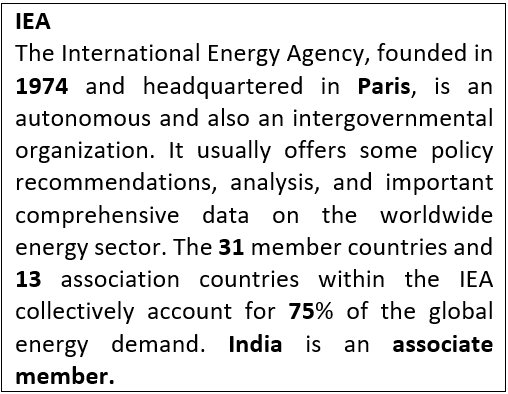- Courses
- GS Full Course 1 Year
- GS Full Course 2 Year
- GS Full Course 3 Year
- GS Full Course Till Selection
- Answer Alpha: Mains 2025 Mentorship
- MEP (Mains Enrichment Programme) Data, Facts
- Essay Target – 150+ Marks
- Online Program
- GS Recorded Course
- Polity
- Geography
- Economy
- Ancient, Medieval and Art & Culture AMAC
- Modern India, Post Independence & World History
- Environment
- Governance
- Science & Technology
- International Relations and Internal Security
- Disaster Management
- Ethics
- NCERT Current Affairs
- Indian Society and Social Issue
- NCERT- Science and Technology
- NCERT - Geography
- NCERT - Ancient History
- NCERT- World History
- NCERT Modern History
- CSAT
- 5 LAYERED ARJUNA Mentorship
- Public Administration Optional
- ABOUT US
- OUR TOPPERS
- TEST SERIES
- FREE STUDY MATERIAL
- VIDEOS
- CONTACT US
Mission LiFE Implementation Toolkit
Mission LiFE Implementation Toolkit
Context
Recently, IEA (International Energy Agency) released a report, “A Policy Toolkit for Implementing LiFE,” which provides a concrete roadmap for advancing LiFE implementation.

Key Objectives of Policy Implementation toolkit
1. Awareness Generation: Well-designed awareness campaigns motivat e people to reduce their energy use and help to shape environmental consumer choices and habits.
e people to reduce their energy use and help to shape environmental consumer choices and habits.
2. Information Accessibility: While campaigns focus on raising the broad level of awareness, information accessibility relates to the provision of specific information at the point of purchase or use.
3. Status Quo nudging: Policy makers can use this status quo bias to nudge energy consumers towards choosing the most environmentally friendly solution as a default choice.
4. Financial Measures: Financial incentives and price signals can have a huge influence on consumer behaviour and help promote cleaner alternatives
5. Mandatory Standards: Regulation can contribute to rapid market transformation, and is important also to set rules for measurement and performance.
6. Public Investments: incentives for choosing low-emissions technologies and changing daily habits must be combined with public investments
Challenges in implementation of LiFE |
Significance of LiFE |
|
Behavioral Change: Encouraging widespread adoption of sustainable practices poses a challenge, requiring effective communication and education to shift entrenched habits within communities. |
Carbon Footprint Reduction: By encouraging eco-friendly habits, LiFE aids in lowering carbon footprints, mitigating climate change, and promoting a more sustainable and resilient future - by almost 1.7 billion tonnes in 2030. |
|
Infrastructure: Inadequate green infrastructure and facilities hinder the seamless integration of eco-friendly practices, demanding significant investments in sustainable alternatives. |
Environmental Stewardship: LiFE promotes sustainable living, fostering responsible consumer choices and waste reduction, contributing to environmental preservation and ecological balance. |
|
Policy Alignment: Coordinating LiFE initiatives with existing policies and regulations presents challenges, necessitating a harmonized approach for effective environmental governance. |
Resource Conservation: Implementation of LiFE leads to reduced resource consumption, conserving water, energy, and raw materials, thus contributing to the efficient use of natural resources. |
|
Resource Constraints: Limited resources and funding impede the scalability of LiFE initiatives, demanding innovative financing models and public-private partnerships for sustained impact. |
Biodiversity Protection: Adopting LiFE practices supports biodiversity conservation by minimizing habitat destruction and pollution, ensuring ecosystems thrive for future generations. |
|
Cultural Diversity: Tailoring LiFE initiatives to diverse cultural contexts requires nuanced strategies to ensure relevance and acceptance, acknowledging the cultural variations in environmental attitudes and practices. |
Community Engagement: LiFE fosters a sense of environmental responsibility, promoting community engagement in sustainable practices, creating a collective impact towards a healthier planet |
Way Froward
The onus rests on governments to explain in a transparent manner not only how re- assessing one’s own consumption choices is essential to meet climate goals, but also to emphasise the many co-benefits, including improved health and well-being, cleaner air, less traffic congestion, cheaper fuel bills and fewer road traffic injuries



